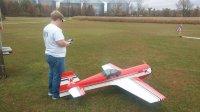Well, 'slightly more control authority in high alpha' is the result of what they do... they extend the AoA where the break from laminar to turbulent flow occurs. As long as there is laminar flow, air gets to the control surfaces. When separation occurs, turbulence begins, and along with turbulence comes drag and aileron control departure.
In most 3D maneuvers, we hope for a laminar flow until the airspeed gets to the point where only vectored thrust from the propeller influences lift and control because wings going from laminar to turbulent flow creates and perpetuates wing rock.
This is all about trade offs in design. A thinner wing reduces drag at zero AoA but promotes turbulence quicker in lower angles. A thicker wing promotes more stability in higher alphas, but increase the drag coefficient at zero AoA. So the band aids for thinner airfoils are VGs.
Winglets on the wing tips of the MXS in the Red Bull Air Races counter the vortex, and turbulence it creates, when air spills from the high pressure on the bottom of the wing tip to the top of the wingtip where the pressure is lower. That combines with the laminar flowing air and creates a vortices. The winglet blocks the air from spilling over the tip, reduces the vortex, and reduces the drag at the wingtip. This will not only decrease drag, but also increase the efficiency of the outboard section of the aileron and increase the roll rate.

